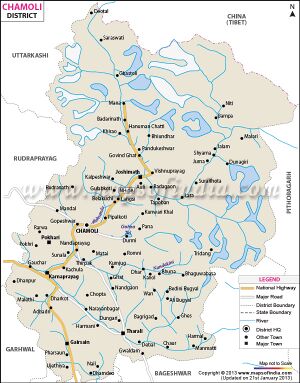Adibadari
- For another place of this name see Adi Badri Haryana
| Author:Laxman Burdak, IFS (R) |

Adibadari (आदि-बदरी) is a pilgrim located in the hill ranges 17 kms, beyond Karnaprayag in Chamoli district of Uttarakhand.
Variants
- Adi-badari/Adi Badri (आदि-बदरी) (जिला गढ़वाल, उ.प्र.) (AS, p.62)
Origin
History
The Adi Badri (30°27′27″N 77°20′28″E) the first temple complex among the Sapta Badri temples is an ancient shrine dedicated to Vishnu and is one among a chain of 16 small shrines located in the hill ranges 17 kms, beyond Karnaprayag (confluence of Pindar River and Alaknanda River in Chamoli district. Seven temples of this chain were built during the late Gupta period (5th century to 8th century). According to tradition, Adi Shankara is attributed as builder of all the temples.[1]
Adi Shankara is believed to have sanctioned these temples in order to spread Hinduism to every remote part of the country.[2] In ancient times, when approach to the main shrine of Badrinath was closed due to weather conditions, pilgrims worshipped Vishnu at this temple. Adi Badri, also known as Helisera according to revenue records, is a tiny temple complex enclosed within a space of 14 metres (46 ft) X 30 metres (98 ft). The height of the temples vary from 2–6 metres (6.6–19.7 ft). The chief temple is dedicated to god Vishnu, which is built over a raised platform, with a small enclosure in a pyramidal form. The sanctum holds black stone 1 metre (3.3 ft) image of Vishnu.[3]
Adi Badri is located 3 kms from Chandpur fort or Garhi located on the hilltop, which was built by the Parmar kings of garhwal. Adi Badri is an hour's drive from Karnaprayag and close to Chulakot on the way to Ranikhet.[4]
आदिबदरी
विजयेन्द्र कुमार माथुर[5] ने लेख किया है ...आदिबदरी (AS, p.62) उत्तराखंड राज्य के परगना चाँदपुर में कर्णप्रयाग से लगभग 11 मील दक्षिण में स्थित है। यहाँ सोलह प्राचीन मंदिर हैं जिन्हें किंवदंती के अनुसार शंकराचार्य ने बनवाया था। किंतु ये वास्तव में चाँदपुरी गढ़ी के प्राचीन राजाओं द्वारा निर्मित हैं।
External links
References
- ↑ Bansal, Sunita Pant (2005). "Badrinath". Hindu Gods and Goddesses. Smriti Books. p. 35. ISBN 978-81-87967-72-9.
- ↑ Sati, Vishwambhar Prasad; Kumar, Kamlesh (2004). Uttaranchal: Dilemma Of Plenties And Scarcities. Mittal Publications. pp. 204–6. ISBN 978-81-7099-898-3.
- ↑ Bansal, Sunita Pant (2005). "Badrinath". Hindu Gods and Goddesses. Smriti Books. p. 35. ISBN 978-81-87967-72-9.
- ↑ Nigam, Devesh (2002). "Panch Badris". Tourism, environment, and development of Garhwal Himalaya. Mittal Publications. pp. 16–18.
- ↑ Aitihasik Sthanavali by Vijayendra Kumar Mathur, p.62

